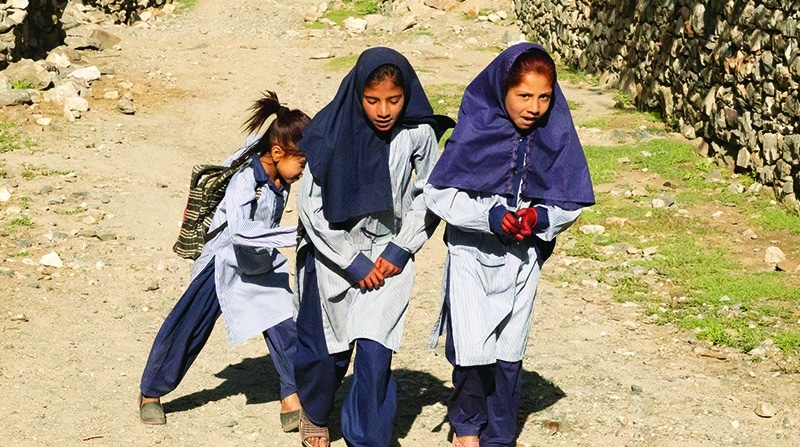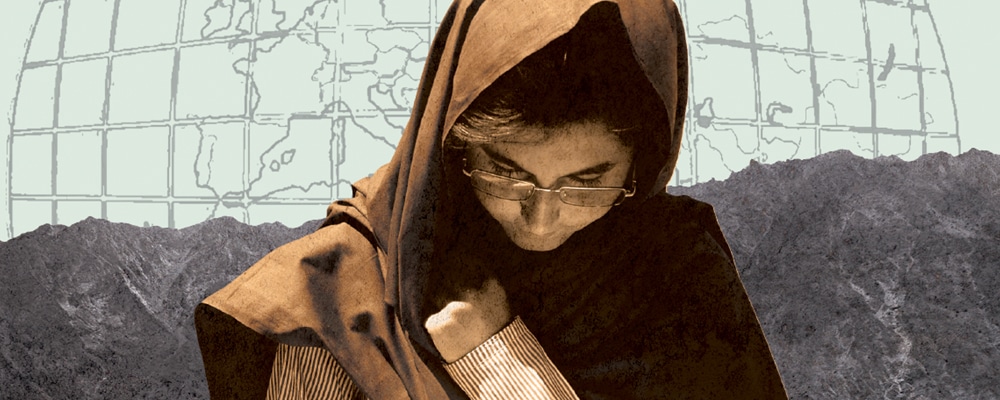What does girls’ education have to do with climate change?
By Alice Thomas
Across the globe, people are feeling the effects of climate change—from hurricanes to flooding to droughts to wildfires. Tragically, the poorest, most marginalized people are often the hardest hit.
In the regions of Central Asia where CAI works, extreme weather is a part of life. But as the climate changes, poor and vulnerable communities are finding it harder to cope. Adding to the problem is that governments in this region have limited capacity to prepare for and respond
to disasters.
For example, Afghanistan is currently facing a severe drought that comes on the heels of the 2018-2019 drought. As of early September 2021, some 7 million Afghans who depend on agriculture and raising livestock to survive required humanitarian assistance.i With lower-than-usual harvests expected this fall, Afghan farmers are bracing for the worst this winter. Even before the government fell to the Taliban, former President Ashraf Ghani acknowledged that the government lacked the funds and capacity to manage the impending crisis.
While climate change is impacting all regions in the world, ecologically fragile, high-mountain areas face unique risks. Nowhere is this more evident than the remote and mountainous areas of Afghanistan, Pakistan, and Tajikistan, where CAI has long focused. The Pamir, Karakoram, and Himalayan ranges are part of the broader Hindu Kush Himalayan (HKH) region, which is known as the “Roof of the World” because it has some of the tallest peaks on Earth. Many are covered with deep glaciers and serve as water towers on which billions of people living in the broader Asia region depend for fresh water and food.
But in recent years, warmer temperatures have accelerated glacial melting, resulting in more intense flooding and, over the long term, depletion of water sources. The United Nations recently warned that even conservative scenarios for future global warming indicate that the region will lose one-third of its ice volume by the year 2100.ii
“I have noticed that the number of glaciers is decreasing, and the glaciers are melting and causing natural disasters like mudslides,” explained one senior geologist from Tajikistan who helps communities prepare for the effects of climate change. “The water level of the rivers is getting higher, washing out the roads and the crop fields.”
Farmers in the region are noticing the changes as well. Gulru and her family have been farming their plot of land for more than 60 years. “The climate has changed a lot,” she said. “Before we had very good harvest from our little field, but this year our field was destroyed by a mudslide. Then, after we cleaned the field and planted vegetables, the harvest was not good. There wasn’t enough rain and all the crops dried up. So, this year we have to buy our vegetables from the market.”

But what does the issue of climate change have to do with women, girls, and education?
In the HKH region and other poor and ecologically fragile parts of the globe, women and girls bear the brunt of extreme weather and climate change. Poverty and other economic, social, and cultural factors act to heighten their vulnerability to climate change impacts. At the same time, they have far less access than men to the resources, knowledge, and decision-making that would help them to recover and adapt.
For example, when disasters like flash flooding or typhoons occur, women and girls are far more likely to be killed or displaced. Females living in displacement camps also face a heightened risk of sexual exploitation and abuse.
In the case of long-term disasters like droughts, socio-cultural norms and childcare responsibilities can prevent women from migrating to urban areas to seek
assistance or find jobs. When food is scarce, mothers often forgo meals so that the males and small children can eat. They must also travel greater distances to get water, increasing the risk of
gender-based violence.
Climate-related disasters have also been shown to contribute to a rise in early childhood marriages by exacerbating poverty and incentivizing families to marry off young daughters. Girls are also more likely than boys to drop out of school when their families are facing environmental crises.
The same social, economic, and cultural factors that make women and girls more vulnerable to extreme weather often prevent them from participating in solutions.iii Because women in the remote communities CAI serves are often illiterate and lack resources, they are less equipped to adapt to climate change. And because they aren’t included in decision-making and planning processes, they are unable to participate in devising climate solutions.
The good news is that research shows that educating women and girls may be one of the best ways to overcome these problems. Education not only opens the door to more opportunities, it also allows women to be better stewards of the environment while building their resilience to extreme weather and the impacts of climate change.
Education provides a pathway for putting women and girls at the forefront of climate change solutions.
In addition, education plays an important role in promoting female reproductive health and rights. Studies show that women who are educated have healthier births and greater control over their bodies. They can better decide when to have children and how many to have. According to Project Drawdown, a nonprofit organization that works on climate solutions and research, “Estimates suggest that together with family planning, girls’ education has the potential of avoiding nearly 85 gigatons of carbon emissions by 2050.”iv That’s a big reduction considering that in 2020, global carbon emissions from fossil fuels were 9.3 gigatons.v In fact, Project Drawdown includes girls’ education as one of the top 10 strategies for combating global warming.
Another factor supporting girls’ education as an effective strategy for addressing climate change is that women have been shown to make excellent environmental leaders. Studies have linked female leadership, which obviously requires education, to better environmental policies and decreased climate pollution.
When looking to the future, it’s also critical to ensure that girls and women get the education, training, and skills they need to prepare themselves for green jobs in the new green economy. This will require not only enabling girls to participate in STEM (science, technology, engineering, and math) education, but also developing their empowerment skills and helping them actively participate in decisions affecting the societies in which they live.vi
In short, without the participation of women and girls, we have little hope of minimizing the worst effects of climate change.
In the countries where CAI works, access to quality education is limited, especially for girls. Afghanistan and Pakistan have some of the highest rates of out-of-school children in the world, and the majority of them are girls. In Tajikistan, girls tend to drop out before reaching high school at a higher rate than boys, and fewer girls complete their secondary education and attend university.
With the support of our dedicated donors, CAI is working to increase girls’ and women’s access to quality education. But making educational opportunities available to girls and women serves a much broader purpose. For girls and women, education is key to unlocking their full potential. It empowers them to thrive. And when girls and women thrive, so do their families, communities, and countries.
We know that tackling climate change can seem like a huge, unsolvable challenge. Yet we know that advancing girls’ education is a proven strategy for helping to solve many of the world’s other, seemingly unsolvable problems – such as poverty, poor health, and insecurity. The same holds true for humankind’s greatest challenge – climate change. We know, as you do, that when you educate a girl, you truly are changing the world!
i. McCarthy, J. (2020, March 5). Change Impacts Women More Than Men. In Global Citizen.
United Nations. (2021, August 16). Five ways climate change hurts women and girls. In United Nations Population Fund.
ii. Policy Brief: Melting Glaciers, Threatened Livelihoods: Confronting Climate Change to Save the Third Pole (2021, June). In UNDP.
iii. Osman-Elasha, B. (2013). Women…In The Shadow of Climate Change. In UN Chronicle.
iv. Hawken, P. (2017). Drawdown: The Most Comprehensive Plan Ever Proposed to Reverse Global Warming.
v. Mkitarian, J. (2020, December). 2020 Global Carbon Budget. In Global Ocean Monitoring and Observation. https://globalocean.noaa.gov/News/2020-global-carbon-budget-released-1
vi. Kwauk, C. (2021, February). Why is girls’ education important for climate action? In Brookings.






